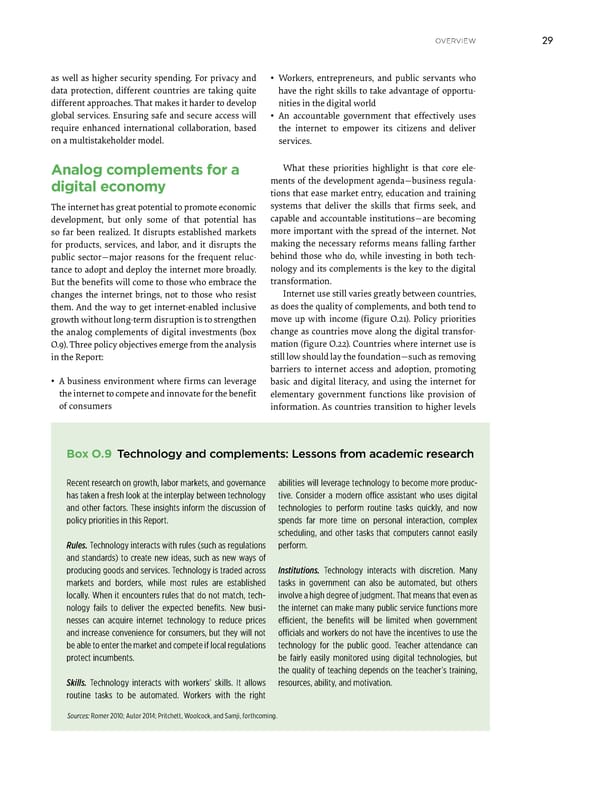overview 29 as well as higher security spending. For privacy and • Workers, entrepreneurs, and public servants who data protection, different countries are taking quite have the right skills to take advantage of opportu- different approaches. That makes it harder to develop nities in the digital world global services. Ensuring safe and secure access will • An accountable government that effectively uses require enhanced international collaboration, based the internet to empower its citizens and deliver on a multistakeholder model. services. Analog complements for a What these priorities highlight is that core ele- digital economy ments of the development agenda—business regula- tions that ease market entry, education and training The internet has great potential to promote economic systems that deliver the skills that firms seek, and development, but only some of that potential has capable and accountable institutions—are becoming so far been realized. It disrupts established markets more important with the spread of the internet. Not for products, services, and labor, and it disrupts the making the necessary reforms means falling farther public sector—major reasons for the frequent reluc- behind those who do, while investing in both tech- tance to adopt and deploy the internet more broadly. nology and its complements is the key to the digital But the benefits will come to those who embrace the transformation. changes the internet brings, not to those who resist Internet use still varies greatly between countries, them. And the way to get internet-enabled inclusive as does the quality of complements, and both tend to growth without long-term disruption is to strengthen move up with income (figure O.21). Policy priorities the analog complements of digital investments (box change as countries move along the digital transfor- O.9). Three policy objectives emerge from the analysis mation (figure O.22). Countries where internet use is in the Report: still low should lay the foundation—such as removing barriers to internet access and adoption, promoting • A business environment where firms can leverage basic and digital literacy, and using the internet for the internet to compete and innovate for the benefit elementary government functions like provision of of consumers information. As countries transition to higher levels Box O.9 Technology and complements: Lessons from academic research Recent research on growth, labor markets, and governance abilities will leverage technology to become more produc- has taken a fresh look at the interplay between technology tive. Consider a modern office assistant who uses digital and other factors. These insights inform the discussion of technologies to perform routine tasks quickly, and now policy priorities in this Report. spends far more time on personal interaction, complex scheduling, and other tasks that computers cannot easily Rules. Technology interacts with rules (such as regulations perform. and standards) to create new ideas, such as new ways of producing goods and services. Technology is traded across Institutions. Technology interacts with discretion. Many markets and borders, while most rules are established tasks in government can also be automated, but others locally. When it encounters rules that do not match, tech- involve a high degree of judgment. That means that even as nology fails to deliver the expected benefits. New busi- the internet can make many public service functions more nesses can acquire internet technology to reduce prices efficient, the benefits will be limited when government and increase convenience for consumers, but they will not officials and workers do not have the incentives to use the be able to enter the market and compete if local regulations technology for the public good. Teacher attendance can protect incumbents. be fairly easily monitored using digital technologies, but the quality of teaching depends on the teacher’s training, Skills. Technology interacts with workers’ skills. It allows resources, ability, and motivation. routine tasks to be automated. Workers with the right Sources: Romer 2010; Autor 2014; Pritchett, Woolcock, and Samji, forthcoming.
 World Development Report 2016 Page 44 Page 46
World Development Report 2016 Page 44 Page 46